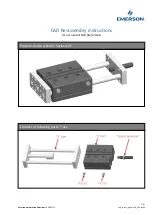
WEDGE
EXIT
WEDGE
EXIT
FRONT OF MACHINE
P2
B
P1
P3
B1
B2
B
E
E
E
7
Standing in the work position used of reference for explanations (behind the machine; see
Fig 2, page 1), with your left hand, put the first moulding chop in front of the left (1
st
)
backfence B1 and bring the chop in contact
with the right (2
nd
) backfence B2.
For the stapling position close to the inside
of the frame :
Move the 90° joining angle backwards, until
you have reached the furthest
position to the inside of the frame where you
want to insert wedge(s).
Then bring the lever P1 against the limit stop
B and tighten the lever.
Now the two positions of joining are set and
the machine’s 90° angle can move only
within the limits of these two positions.
In case you would like to insert wedges in between these two positions, or if you are
working with a very small moulding and would like to insert wedges only in one place, you
can use the lever P3 located on the limit stop B.
This intermediate lever P3 also enables you to stack wedges (on top of each other in the
same position) without risk of missing the stacking operation (not pushing the first wedge
deeper inside).
For the stapling position close
to the outside of the frame :
Move forward the 90° joining angle assembly
E
until the place where you want to insert the
wedge(s) has been reached by the
WEDGE
EXIT
(see picture). Then bring the lever
P2
against the limit stop
B
and tighten it.
If the corner is open towards outside, unscrew (turn anti-clockwise) the angle adjustment
screw AS (see Fig 1 page 1) a little to correct the fault and check again.
ADJUSTMENT OF THE ASSEMBLY ANGLE
If several cutting machines are being used in your production or if you receive your
mouldings already cut by your suppliers (chop service), the angles of the mouldings will
be slightly different from one cutting machine to the other. The joining angle of your CS
59 can be adapted to find precisely the cutting angle of your cutting machine.
If the corner is open towards inside, screw in (turn clock-wise) the angle adjustment screw
AS (Fig 1 page 1) to correct the fault.
If you get this result, check your cutting angle, which is wrong
in this case because it is less than 45°
.
Carry out the adjustment of the angle of your cutting
machine.
IT IS IMPOSSIBLE TO MAKE A RECTANGLE
FRAME WITH ANGLES SMALLER THAN 90°.
Outside
Inside
8
Make sure that the distance between the moulding’s top
and the presser’s bottom is not more than 30 mm (1 ¼”).
If the distance is bigger than this, use another (longer)
top presser to reduce the distance.
PRESSER
MOULDING
30 mm (1
1/4’
’)
MAXIMUM
SELECTION OF A TOP PRESSER END
Triangle top pressers are good for flat mouldings
or for mouldings presenting a flat or horizontal
area to come down on. The green or orange rubber
ends are good for complicated forms (uphill,
downhill or reverse mouldings).
BLACK TRIANGLE PRESSER
FOR HARDWOODS
Fixing in support with
WHITE TRIANGLE PRESSER
FOR SOFT WOODS
2.5 mm Allen key.
GREEN ROUND RUBBER ENDS
FOR HARDWOODS
1 long and 1 short
YELLOW ROUND RUBBER ENDS
FOR SOFT WOODS
1 long and 1 short
Содержание CS 59
Страница 21: ......







































